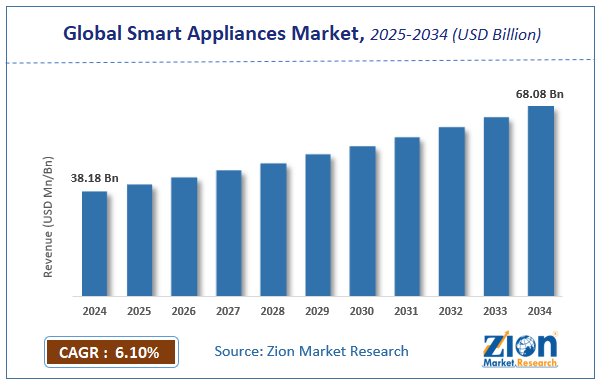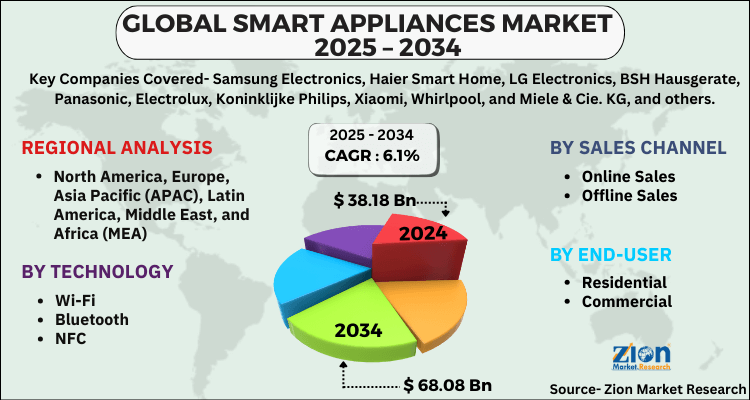Smart Appliances Market Size, Share, Growth Report, 2034

Smart Appliances Market - By Technology (Wi-Fi, Bluetooth, NFC, and Others), By Sales Channel (Online Sales and Offline Sales), By End-User (Residential and Commercial), and By Region: Global and Regional Industry Overview, Market Intelligence, Comprehensive Analysis, Historical Data, and Forecasts 2025 - 2034
| Market Size in 2024 | Market Forecast in 2034 | CAGR (in %) | Base Year |
|---|---|---|---|
| USD 38.18 Billion | USD 68.08 Billion | 6.1% | 2024 |
Smart Appliances Market: Industry Perspective
The global smart appliances market size was worth around USD 38.18 Billion in 2024 and is predicted to grow to around USD 68.08 Billion by 2034 with a compound annual growth rate (CAGR) of roughly 6.1% between 2025 and 2034. The report analyzes the global smart appliances market's drivers, restraints/challenges, and the effect they have on the demands during the projection period. In addition, the report explores emerging opportunities in the smart appliances industry.
The report analyzes the global smart appliances market's drivers, restraints/challenges, and the effect they have on the demands during the projection period. In addition, the report explores emerging opportunities in the smart appliances industry.
Smart Appliances Market: Overview
Appliances that are connected to a central system and can be programmed & controlled remotely or autonomously using electronic systems such as sensors, IoT, lights, etc. are categorized under smart appliances. A smart appliance is a more advanced version of a traditional appliance that is controlled by a network of linked devices. Tablets, computers, and smartphones are examples of linked gadgets that are designed to provide greater control and information.
Advanced smart appliances are studied and created to function according to the needs of the user, and the user is told when it is time to turn them off. Smart appliances include an energy-efficient function that allows the end-user to operate with little power usage.
Key Insights
- As per the analysis shared by our research analyst, the global smart appliances market is estimated to grow annually at a CAGR of around 6.1% over the forecast period (2025-2034).
- Regarding revenue, the global smart appliances market size was valued at around USD 38.18 Billion in 2024 and is projected to reach USD 68.08 Billion by 2034.
- The smart appliances market is projected to grow at a significant rate due to increasing adoption of iot-enabled home appliances, energy efficiency concerns, and growing consumer demand for convenience.
- Based on Technology, the Wi-Fi segment is expected to lead the global market.
- On the basis of Sales Channel, the Online Sales segment is growing at a high rate and will continue to dominate the global market.
- Based on the End-User, the Residential segment is projected to swipe the largest market share.
- Based on region, Asia-Pacific is predicted to dominate the global market during the forecast period.
Smart Appliances Market: Growth Drivers
Introduction of new technologies and access to the internet to boost the market growth
Smart appliances must be connected to the internet to provide consumers with 'smart' functions. Smart appliances would cease to be 'smart' if they lack additional features and functions, which always necessitate an internet connection. Smart appliances have become more accessible as the internet has grown in popularity. Furthermore, the number of smartphone users has skyrocketed in recent years.
Another development driving the market is the introduction of new technologies and compact devices that occupy less space but provide improved functionality. Users are drawn to smart appliances because of the ease with which they can monitor them using their smartphones or tablets. It's a huge benefit to be able to link all of your household appliances over the internet with a single interface.
Smart Appliances Market: Restraints
Hacking and privacy issues are expected to restrict the market growth
Users of smartphones and the internet are concerned about the possibility of their personal information, such as their name, email address, home address, date of birth, and credit card credentials, being shared and seen. Furthermore, smart appliances are mostly managed by smartphone applications developed by emerging firms; corporations gather user data through these applications, further raising consumer concerns about data privacy. As a result, privacy issues might be a stumbling block to the expansion of the global smart appliance market.
Smart Appliances Market: Opportunities
Work-from-home culture and requirement to automate chores
People have begun to stay at home since the advent of the COVID-19 epidemic. As a result, in the last year, people's reliance on the internet and digital devices has grown. Because individuals aren't going out as much, key day-to-day spending has plummeted. People's discretionary income has grown as a result of this.
Furthermore, because people are remaining at home, smart gadgets are being utilized more than before the epidemic. This opens up a lot of potential for smart appliance makers and suppliers to come up with more unique and user-friendly features in their products to attract customers.
Smart Appliances Market: Challenges
Durability and compatibility issues among appliances pose challenges to market growth
Many manufacturers are working on various systems that use a variety of technologies for smart appliances. It is simple to integrate and connect devices from the same manufacturer or vendor; however, linking systems from multiple manufacturers or suppliers is a time-consuming job that might result in restricted functionality and unreliable services, in addition to incompatibility difficulties.
Secondly, in the era of plastics and new production materials, several appliances are delicate and not durable. As a result, the lack of durability and the problem of device compatibility pose a hindrance to the market's growth.
Smart Appliances Market: Segmentation
The global smart appliances market is segmented based on technology, sales channel, end-user, and region.
In terms of technology, four main segments exist namely Wi-Fi, Bluetooth, NFC, and Others.
In terms of sales channels, two main segments exist, which are online sales and offline sales. With the rising trend towards online purchases and COVID-19 restrictions, people have been inclined towards the online sales segment, purchasing products online, rather than offline stores. This segment promises the potential for the smart appliance market.
In terms of end-users, this market can be divided into residential and commercial. The residential segment is expected to grow widely, given the increased number of work-from-home employees looking to make life easier. The change in lifestyle and the mass population opting for luxury smart appliances will also fuel this growth.
Smart Appliances Market: Report Scope
| Report Attributes | Report Details |
|---|---|
| Report Name | Smart Appliances Market |
| Market Size in 2024 | USD 38.18 Billion |
| Market Forecast in 2034 | USD 68.08 Billion |
| Growth Rate | CAGR of 6.1% |
| Number of Pages | 185 |
| Key Companies Covered | Samsung Electronics, Haier Smart Home, LG Electronics, BSH Hausgerate, Panasonic, Electrolux, Koninklijke Philips, Xiaomi, Whirlpool, and Miele & Cie. KG, and others. |
| Segments Covered | By Technology, By Sales Channel, By End-User, and By Region |
| Regions Covered | North America, Europe, Asia Pacific (APAC), Latin America, The Middle East and Africa (MEA) |
| Base Year | 2024 |
| Historical Year | 2020 to 2023 |
| Forecast Year | 2025 - 2034 |
| Customization Scope | Avail customized purchase options to meet your exact research needs. Request For Customization |
Smart Appliances Market: Regional Landscape
North America is likely to govern the global smart appliances market during the forecast period. The United States and Canada, out of all the areas, are seen to have a growing adoption rate of IoT devices and achieving the position of leading countries in the region.
Furthermore, due to the high demand rate, Asia Pacific is expected to be the fastest-growing area in the smart appliances market, yielding the most profit. In the Asia Pacific region, the smart appliance manufacturing market in India, South Korea, Japan, and China is constantly expanding.
Recent Developments
- In 2021, LG Electronics released the LG CordZeroThinQ A9 vacuum cleaner equipped with two special modes with moping for a hassle-free cleaning experience. The cordless feature became a revolution in the vacuum cleaner market.
- In 2020, Haier Smart Home launched a new rooftop air conditioner with a heat pump and a high-efficiency product. The heat from the outside is piped into the interior of RVs using the new AC to support furnace running revolutionizing the competition in the air conditioning market.
Smart Appliances Market: Competitive Landscape
The report provides a company market share analysis to give a broader overview of the key market players. In addition, the report also covers key strategic developments of the market, including acquisitions & mergers, new product launches, agreements, partnerships, collaborations & joint ventures, research & development, and regional expansion of major participants involved in the smart appliances market on a global and regional basis.
The global smart appliances market is dominated by players like:
- Samsung Electronics
- Haier Smart Home
- LG Electronics
- BSH Hausgerate
- Panasonic
- Electrolux
- Koninklijke Philips
- Xiaomi
- Whirlpool
- Miele & Cie. KG
The global smart appliances market is segmented as follows:
By Technology
By Sales Channel
- Online Sales
- Offline Sales
By End-User
- Residential
- Commercial
By Region
- North America
- The U.S.
- Canada
- Europe
- France
- The UK
- Spain
- Germany
- Italy
- Rest of Europe
- Asia Pacific
- China
- Japan
- India
- South Korea
- Southeast Asia
- Rest of Asia Pacific
- Latin America
- Brazil
- Mexico
- Rest of Latin America
- Middle East & Africa
- GCC
- South Africa
- Rest of the Middle East & Africa
Table Of Content
Methodology
FrequentlyAsked Questions
The global smart appliances market is expected to grow due to increasing adoption of iot-enabled home automation, rising consumer preference for energy-efficient appliances, and technological advancements.
According to a study, the global smart appliances market size was worth around USD 38.18 Billion in 2024 and is expected to reach USD 68.08 Billion by 2034.
The global smart appliances market is expected to grow at a CAGR of 6.1% during the forecast period.
Asia-Pacific is expected to dominate the smart appliances market over the forecast period.
Leading players in the global smart appliances market include Samsung Electronics, Haier Smart Home, LG Electronics, BSH Hausgerate, Panasonic, Electrolux, Koninklijke Philips, Xiaomi, Whirlpool, and Miele & Cie. KG, among others.
The report explores crucial aspects of the smart appliances market, including a detailed discussion of existing growth factors and restraints, while also examining future growth opportunities and challenges that impact the market.
RelatedNews
HappyClients
Zion Market Research
Tel: +1 (302) 444-0166
USA/Canada Toll Free No.+1 (855) 465-4651
3rd Floor,
Mrunal Paradise, Opp Maharaja Hotel,
Pimple Gurav, Pune 411061,
Maharashtra, India
Phone No +91 7768 006 007, +91 7768 006 008
US OFFICE NO +1 (302) 444-0166
US/CAN TOLL FREE +1 (855) 465-4651
Email: sales@zionmarketresearch.com
We have secured system to process your transaction.
Our support available to help you 24 hours a day, five days a week.
Monday - Friday: 9AM - 6PM
Saturday - Sunday: Closed






